Exploring the Waist Leash in Kiteboarding Equipment
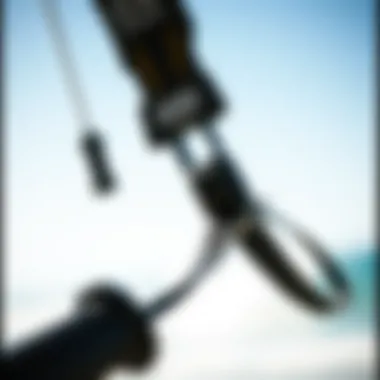
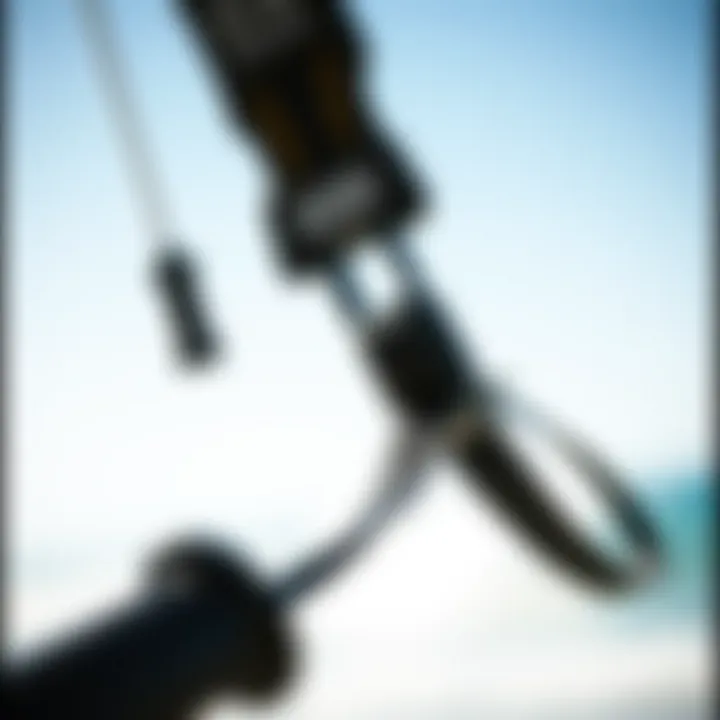
Intro
When it comes to kiteboarding, figuring out the right gear can be like choosing a new flavor of ice cream—overwhelming but exciting. A key piece of equipment that often gets overlooked, yet plays a crucial role, is the waist leash. The waist leash is not just there for show; it offers a blend of convenience and safety for riders in various water conditions.
In kiteboarding, the dynamics of how the kite operates are influenced significantly by the rider's movements. The waist leash allows for greater mobility than traditional leashes, meaning you can twist and turn without feeling constrained. Riders often find that having a waist leash can dramatically enhance their overall experience on the water.
This article will examine the ins and outs of the waist leash—its functionalities, advantages, and how it stands apart from the more traditional forms of leashes. Beyond that, we'll touch on practical tips for selecting a suitable waist leash, how to maintain it for longevity, and everything else that comes into play for kiteboarding enthusiasts. By the end, you'll have a better understanding of this critical piece of equipment, so you can make informed decisions, whether you're trying to catch some waves for the first time or looking to refine your skills.
So, grab a drink, take a seat, and let’s dive deep into the world of waist leashes in kiteboarding.
Preamble to the Waist Leash
In the exhilarating world of kiteboarding, the waist leash plays a pivotal role, acting as a lifeline between the rider and the kite. This piece of equipment not only enhances the overall kiteboarding experience but also ensures safety while gliding across water. Given the unpredictable nature of wind and waves, having a reliable waist leash is crucial for riders of all skill levels. In this article, we will explore various dimensions of waist leashes, including their definition, historical context, and their importance in the sport.
Definition and Purpose
A waist leash can be defined as a tether attached at a rider's waist, connecting them to the kite via a longer cord. Unlike traditional leashes that attach to the ankle or foot, the waist leash provides an increased range of motion and flexibility. This design aids in maneuverability, allowing riders to perform tricks and navigate challenging conditions with greater ease.
The primary purpose of a waist leash is to maintain control of the kite while ensuring the rider can release it quickly in case of an emergency. This feature is especially important during wipeouts or sudden changes in wind patterns, providing an added measure of safety. Overall, the waist leash serves as a balance between freedom and security, allowing kiteboarders to enjoy their ride without feeling confined.
Historical Context of Waist Leashes
The evolution of the waist leash stems from the need for improved safety and performance in kiteboarding. Back in the day, kiteboarders primarily relied on ankle leashes, which limited their capacity to execute advanced maneuvers. As the sport progressed, so did the equipment. The shift to waist leashes emerged in the early 2000s when athletes recognized that a more versatile connection to the kite could enhance their skills.
Innovative kiteboarding communities began experimenting with designs that allowed for quicker releases and better control. Examples like the Naish Leash and Cabrinha’s Waist Leash emerged during this transformative period, showcasing how materials and designs could change the landscape of kiteboarding.
Ultimately, the transition to waist leashes marked a significant turning point, allowing riders not just to ride but to thrive in any condition. Today, waist leashes are an essential part of kiteboarding gear, reflecting the sport's growth and the continual search for improved safety mechanisms.
"The waist leash is more than just equipment; it's a testament to kiteboarding's evolution and a rider's commitment to safety and performance."
In the following sections, we will delve further into the types of waist leashes available, their key features, and how to choose one that best fits your specific needs.
Types of Waist Leashes
When it comes to kiteboarding, the choice of a waist leash is pivotal for both performance and safety. Each type of waist leash serves a specific purpose and caters to distinct riding styles and preferences. Understanding these variations can greatly enhance your kiteboarding experience, whether you are a seasoned pro or a beginner just dipping one’s toes into the vast ocean of this sport. Let’s dive into the specifics of the most common types of waist leashes.
Standard Waist Leash
The standard waist leash is often the go-to for many kiteboarders. This type provides a solid connection to the kite without the fuss of added features. Made typically from durable materials like nylon or polyester, it withstands the rigors of water sports while maintaining a lightweight profile.
One defining aspect of the standard waist leash is its simplicity in design. It attaches directly to the waist harness, allowing for freedom of movement. Riders appreciate this because it doesn’t hinder their ability to twist, turn, or jump. If you're looking for something no-frills yet reliable, this option is worth considering. The ease of use when connecting and disconnecting adds to its appeal, especially when time is of the essence and the wind is just right to get out on the water.
"The right leash can make a world of difference; it’s like finding the right pair of shoes for a long hike."
Safety Leash Options
Safety always takes precedence in kiteboarding, and safety leashes are tailored specifically for this. The beauty of a safety leash lies in its function to instantly detach from the kite in emergency situations. This kind of leash often comes with a quick-release system, allowing the rider to disconnect from the kite swiftly, minimizing potential accidents and injuries.
Many riders favor safety leashes not only for their peace of mind but also for the added confidence they provide during intense conditions. These leashes are generally slightly longer than standard ones, ensuring a bit more maneuverability when the unexpected occurs. Furthermore, safety leashes can help prevent the kite from getting stuck, which can be a game-changer in tricky situations.
Adjustable Waist Leashes
Flexibility is the name of the game when it comes to adjustable waist leashes. These leashes can be modified to fit various sizes and preferences, making them ideal for kiteboarders who might share gear or those who simply like to switch things up. This customization can enhance your comfort while riding, ensuring that the leash sits securely and does not interfere with your movements.
Adjustable leashes also allow for different riding styles, whether you’re focusing on surf-style riding or more technical tricks that require precise board control. Being able to adjust the tightness or looseness can also impact how the leash reacts in rough water. This adaptability can be especially valuable if you find yourself riding in varying conditions.
In summary, understanding the nuances between the different types of waist leashes can help kiteboarders make informed decisions about their gear. Each type has its strengths and weaknesses, and it’s vital to take into account your individual style, preferences, and safety needs when making a choice. For more insights on gear and kiteboarding techniques, consider visiting kiteforum.com or exploring instructional videos on YouTube.
Key Features of Effective Waist Leashes
When diving into the world of kiteboarding, understanding the essential features of a waist leash is crucial for a safe and enjoyable ride. A waist leash isn't just a trendy accessory; it serves multiple functions that can enhance your overall kiteboarding experience. The interplay between materials, comfort, and durability is what sets apart an effective waist leash from its counterparts. Let's unpack these key elements.
Materials and Design
The foundation of any good waist leash lies in the materials used. Most reputable waists leashes are crafted from high-quality nylon or a blend of synthetic fibers. These materials are not only lightweight but also resist water absorption, which can otherwise add unnecessary weight when you’re out on the sea.
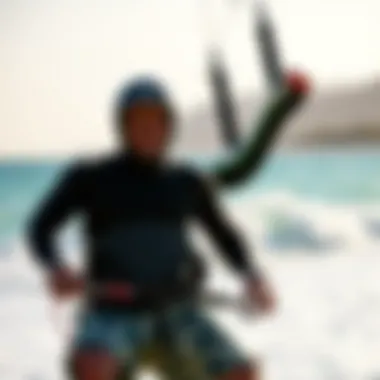

Moreover, the design often incorporates a core of elastic webbing, giving slack where needed while also allowing for a certain level of shock absorption. This makes for a more fluid experience when riding the kite, reducing jerks that could otherwise throw off your balance. For example, the Naish Waist Leash is known for its robust yet pliable materials, offering both reliability and performance.
"The right material can make or break your experience on the water."
Some brands, like Duotone, offer leashes with neoprene padding, which not only enhances comfort during use but also minimizes chafing against your body. The design should also take into account quick-release mechanisms, allowing for rapid disconnection when necessary. For kiteboarders, every second counts.
Comfort and Fit
A waist leash should feel almost like a second skin during your session. The right fit is vital; it shouldn't be so tight that it restricts movement, nor so loose that it flops around. Many modern waist leashes come with adjustable components. This means you can customize the fit to suit your body type or riding style.
If you’re out there battling the wind, a poorly fitted leash could impact your performance—leading not only to discomfort but also to dangerous situations during high speeds or jumps. Look for leashes that feature padded belts or ergonomic designs that conform to your body’s natural shape. Brands such as Ion offer waist leashes designed specifically for comfort, giving you peace of mind when catching waves.
Durability and Strength
Durability is where the rubber meets the road. A good waist leash should withstand not just the elements but also the gnarly pulls from the kite. This means that the stitching and closures need to be top-notch. Reinforced seams are a sign of strength, as is the use of high-tensile strength materials that can endure wear and tear throughout the seasons.
Some riders may opt for leashes that come with a safety release built-in—the durability of such mechanisms is paramount. For instance, the Mystic Safety Leash emphasizes not just performance but the ability to hold up against the forces experienced when things go awry. If your leash fails you when it matters most, you may find yourself on the wrong side of a wave.
Overall, understanding these key features of waist leashes can greatly enrich your kiteboarding outings. Selecting a leash that combines effective materials, a snug fit, and reliable strength is essential—not just for performance but for safety too. By appreciating the nuances of waist leashes, you’re better equipped to tackle the exhilarating challenges that come with this dynamic sport.
Benefits of Using a Waist Leash
The waist leash offers more than just a means to connect a kiteboarder with their gear; it plays a critical role in enhancing the overall experience of kiteboarding. The unique design and functionality of waist leashes not only maximize movement but also boost safety, making it an integral part of any rider's setup. When considering the benefits of a waist leash, several key aspects become clear. These include enhanced freedom of movement, improved safety mechanisms, and ease of use in various conditions. Let’s break these down further.
Enhanced Freedom of Movement
One of the most significant advantages of using a waist leash is the freedom it grants to the rider. The leash is typically worn around the waist, allowing greater mobility compared to other types of leashes like ankle ones. This setup minimizes restrictions on your legs, which can be quite freeing, especially during jumps, turns, or any maneuver that requires agility.
When you’re out on the water, whether you're carving through waves or practicing stunts, having that convenient freedom can mean the difference between landing a trick successfully or sputtering awkwardly into the water. The waist leash does this by keeping the kite close while not impeding your leg movements. Riders often liken this feeling to dance; when your limbs are unrestricted, you can express your skills far more fluidly.
"The beauty of kiteboarding lies in its rhythm; you don't want anything anchoring you down."
Improved Safety Mechanisms
The safety aspect of a waist leash cannot be overlooked. Many modern waist leashes come equipped with quick-release mechanisms that enhance security in case of emergencies. If a situation arises where you need to detach quickly from your kite, reaching for the release mechanism becomes a swift reaction. This is crucial, as being tied to a malfunctioning kite can lead to dangerous situations.
Moreover, waist leashes keep the kite close to the body, reducing the risk of tangling compared to ankle leashes. In scenarios like a sudden shift in wind or when you’re knocked down, maintaining control becomes vital. The design ensures that you can react promptly, and with less chaos, putting emphasis on safe practice in the sport.
Ease of Use in Various Conditions
Kiteboarding can encompass a variety of conditions—from calm, sunny days to bracing stormy winds. The versatility of waist leashes shines in differing contexts. With adjustments that allow for snug fitting, the waist leash can be tailored to your specific needs, ensuring comfort whether you’re in choppy waters or during a smooth glide.
Riders find that waist leashes are easier to manage when launching and landing. Unlike other leashes that can catch on your legs or feet, a waist leash remains securely fastened around your waist, keeping you unencumbered. This not only fosters a more enjoyable experience but also cultivates confidence in dealing with varying outdoor elements.
In summary, the advantages of using a waist leash in kiteboarding cannot be overstated. They enable greater movement, increase safety, and adapt easily to different conditions, making them a preferred choice for many riders. Understanding these benefits is essential for both novices and experienced kiteboarders alike.
Comparison with Other Leash Types
When it comes to kiteboarding, the leash you choose can make a world of difference in your experience on the water. While the waist leash is often favored for its flexibility and comfort, it's essential to understand how it stacks up against other leash types. This section explores both the handle leash and the ankle leash, providing insights into their specific characteristics, advantages, and potential drawbacks, helping you make an informed decision based on your riding style and conditions.
Waist Leash vs. Handle Leash
The handle leash, a more traditional option, connects to the rider's harness using a handle, often situated near the chest. This design tends to offer a more direct and immediate connection to the kite but can sometimes restrict movement. Here's what to consider:
- Freedom of Movement: A waist leash typically allows for greater freedom of movement. It snugly sits around the waist, enabling fluid motion while performing tricks or navigating choppy waters. In contrast, the handle leash can restrict some movements, which may be a hindrance in dynamic situations.
- Safety Considerations: Both leash types have safety features, but they function differently. The waist leash can detach more quickly in emergencies, as it’s designed to come off without needing to reach for a handle. Handle leashes sometimes require a deliberate pull to release, which may not be ideal in high-stress circumstances.
- Comfort Level: If you're going to be out for a long session, comfort matters. Waist leashes tend to sit more smoothly against the body, reducing chafing. On the other hand, handle leashes may cause some discomfort, especially during extended rides where tension can build.
- Gear Compatibility: Consider your existing kit. Some harnesses are designed specifically for handle leashes and may not function as well with waist leashes, and vice versa.
Waist Leash vs. Ankle Leash
Ankle leashes are common in other water sports, such as surfing, but they come with pros and cons when applied to kiteboarding. Here’s how the waist leash holds up:
- Detachment in the Water: One significant advantage of a waist leash is how it allows for rapid detachment. If a rider falls or is knocked down, the waist leash can easily come off without much fuss. Ankle leashes, conversely, can become entangled, which increases the risk of injury or complications when in the water.
- Stability When Riding: Waist leashes offer better stability while riding. They allow the kiteboarder to shift their weight freely without the risk of tripping on an ankle leash, which can also snag on gear or debris in the water.
- Visibility and Identification: When participating in a crowded kiteboarding session, waist leashes can prevent confusion. They are easier to spot than ankle leashes, making it simpler to identify your gear and manage any potential tangles.
- Overall Effectiveness in Varied Conditions: In rough waters or during aggressive maneuvers, a waist leash is generally more effective. Ankle leashes pose Increased risk of catching on obstacles, while waist leashes facilitate better control over the board and kite.
In summary, when choosing the right leash for kiteboarding, understanding the nuances between waist leashes, handle leashes, and ankle leashes is crucial. Each type has its place, but the waist leash often emerges as a top performer for mobility, safety, and comfort in a wide range of conditions.
"Selecting the right leash could be the difference between a flawless session and a frustrating day on the water."
For further reading, check out resources such as Wikipedia on Kiteboarding or Britannica Kiteboarding Articles for a deeper understanding of this sport and its equipment.
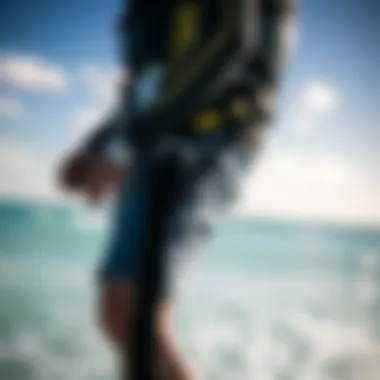
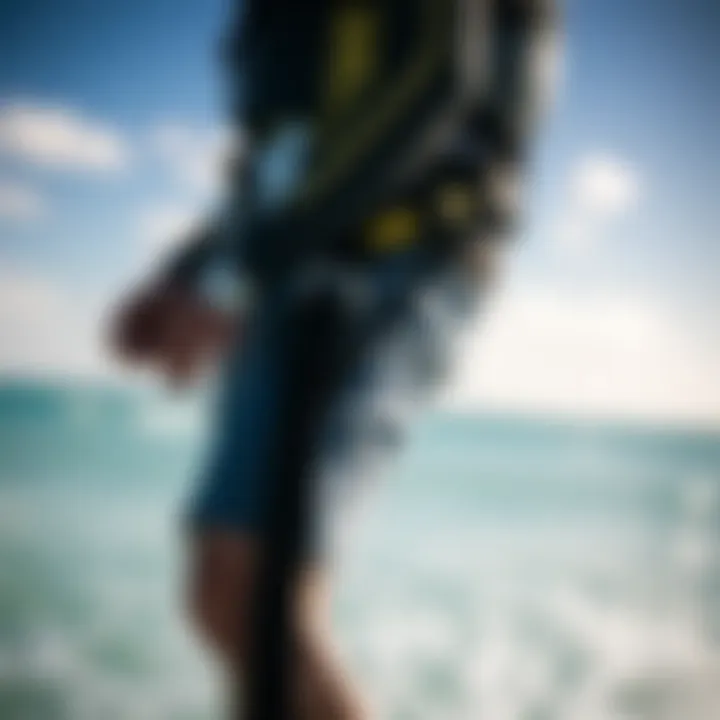
Choosing the Right Waist Leash
Choosing the right waist leash is crucial for kiteboarders, regardless of their experience level. A proper leash can make the difference between a smooth ride and potential hazards on the water. It’s not just about attaching yourself to your kite; it’s about finding a leash that complements your riding style, the conditions you’ll face, and your personal comfort. Here are some important aspects to consider.
Consider Your Riding Style
Different riders have different needs based on their style. For instance, if you’re into freestyle kiteboarding, you might prefer a leash that allows greater freedom of movement so as to execute those mid-air tricks without a hitch. On the other hand, those who enjoy wave riding may opt for a leash designed to withstand the pull and roughness of ocean conditions. Think about the motions and tricks you want to perform, and choose a leash that aligns with that.
- Freestyle Riders: Might choose a thinner, lighter leash that reduces drag.
- Wave Riders: Prefer a more robust leash that can handle turbulent conditions.
- Beginner Riders: Generally benefit from a leash that offers both comfort and security.
Assessing Conditions and Settings
The conditions in which you'll be kiteboarding significantly impact the type of waist leash to choose. It's always a smart play to assess weather patterns, wind strength, and water conditions before hitting the waves. For example:
- Light Winds: A standard leash may suffice, providing enough stability without being overbearing.
- Strong Winds: Consider a leash with more secure attachments and stronger materials to prevent any mid-ride mishaps.
- Variable Conditions: If you’re venturing to an area known for shifting winds or unpredictable waves, a more adjustable leash could be beneficial.
Being aware of local conditions can affect your decision on which waist leash to invest in. Many kiteboarders consult community sites like reddit.com to gather insights on gear suited for specific locations.
Personal Comfort Preferences
The feel and comfort of the waist leash cannot be overlooked. How it sits against your body, whether it chafes or restricts movement, plays a huge role in the overall kiteboarding experience. Here are a few factors to mull over:
- Padding: Look for leashes that have adequate padding, which can help prevent chafing during extended sessions.
- Adjustability: Given that every body type is different, a leash that you can adjust for a snug but comfortable fit makes a world of difference.
- Weight: The lighter the leash, the less noticeable it will be when you’re soaring through the air.
Select a waist leash that feels like an extension of you. When you’re comfortable, you’re able to focus on your moves instead of the gear holding you back.
"A waist leash should feel like a second skin, enhancing your kiteboarding experience rather than hindering it."
Each of these factors plays an integral role in making the right decision. When you consider your riding style, the conditions you’ll face, and your personal comfort preferences, you’re on your way to enhancing your kiteboarding journey.
Proper Usage Techniques for Waist Leashes
Wearing a waist leash in kiteboarding may seem straightforward, yet how you use it fundamentally shapes your experience on the water. Proper usage techniques not only enhance your performance but also ensure safety during your session. Using a waist leash correctly can make the difference between a seamless ride and a potentially dangerous mishap. Let’s break down the essential aspects.
Wearing the Leash Correctly
To make the most out of a waist leash, the first step is wearing it right. It’s not as simple as just strapping it on; adjust it to fit snugly around your waist, ensuring it sits comfortably without slipping.
- Positioning: Ensure that the leash clasp or attachment point is positioned toward the small of your back. This helps prevent it from getting tangled during tricks or wipeouts.
- Adjustment: The waist strap should be tightened adequately but not to the point where it’s uncomfortable or restricts your movement. You should be able to twist and turn without the leash pinching or cutting into your skin.
- Layering: If you wear a wetsuit or harness, consider how those layers interact with your leash. Make sure the leash fits either over or under these garments, avoiding any potential snagging.
Proper wearing doesn’t just keep you comfortable; it also ensures that when the leash is put under strain, it will function correctly, such as releasing the kite if necessary.
Connecting to the Kite Safely
Once your waist leash is on, the next critical step is to connect it to your kite safely. A secure connection can mitigate risks and enhance your control while kiteboarding.
- Connection Check: Before heading out, always inspect the connection point for any wear or damage. A frayed line or a rusty hook can turn a typical session into a trip to the hospital.
- Knot Tying: If your leash has a specific way to tie it onto your harness or kite, follow the manufacturer’s instructions rigorously. For instance, using a figure-eight knot provides solid strength while still being easy to untie.
- Test the Rig: Once connected, pull on the leash a few times firmly. This ensures that everything is secure and you feel confident before launching into the water.
Ensuring a safe and strong connection allows for a more responsive riding experience, as every pull on your kite will translate into movement with less chance of equipment failure.
Remember: A well-fitted leash worn correctly, along with a secure connection to the kite, will keep you safe and amplify your enjoyment on the water.
In summary, mastering these proper usage techniques lays the groundwork for more thrilling and less stressful kiteboarding experiences. It’s a small investment in time that pays off incredibly in the long-run.
Maintenance and Care of Waist Leashes
Proper maintenance and care of waist leashes is crucial for ensuring their longevity and functionality, which directly impacts your safety and performance while kiteboarding. A well-maintained leash not only lasts longer but also operates as designed, which can make a significant difference when you find yourself being pulled by the power of the wind on the water. Ignoring the care of this essential piece of equipment can lead to unexpected failures, which in turn can have serious consequences on your kiteboarding adventures.
By taking into account a few simple maintenance tips, you can keep your waist leash in top form. This section will cover the necessary cleaning procedures and storage recommendations to help prolong the life of your leash and optimize its performance.
Cleaning Procedures
Regularly cleaning your waist leash should become a routine part of your kiteboarding maintenance schedule. This is especially important after a day spent riding in salt or dirty water. Here’s a simple step-by-step guide on how to clean your waist leash effectively:
- Rinse Immediately: Right after your session, rinse your waist leash with fresh water. Saltwater can be corrosive, leading to wear and tear.
- Use Mild Soap: On days when the leash appears particularly dirty, use a mild soap and lukewarm water mixture. Avoid harsh chemicals or solvents as they may weaken the leash material.
- Scrub Gently: With a soft brush or cloth, gently scrub the leash to remove any debris or particles. Focus on areas where dirt tends to accumulate, such as the connector points.
- Dry Thoroughly: After rinsing, hang the leash in a shaded area to air dry completely. Avoid direct sunlight, as UV rays can degrade certain materials over time.
By following these procedures, you minimize the risks associated with degradation, keeping your leash reliable when you need it the most.


Storage Recommendations
Where and how you store your waist leash plays a pivotal role in maintaining its integrity. Here are some recommendations to consider:
- Cool, Dry Place: Store your leash in a cool, dry environment away from moisture and direct sunlight. Humidity can lead to mold and mildew, while UV exposure can weaken the material.
- Avoid Wrinkles: When storing your leash, be sure to lay it flat or roll it up neatly. Hanging it or folding it improperly may create kinks that could weaken it over time.
- Check Regularly: Before each session, take a moment to inspect your leash for any signs of wear or damage. Addressing issues now can prevent bigger problems later.
Even a simple act of proper storage can extend the leash's life significantly, making it a wise practice for any kiteboarder. By investing a little effort into the upkeep of your waist leash, you'll not only save money in the long run, but also ensure a smoother and safer ride on the water.
Common Issues and Troubleshooting
Understanding the common problems associated with waist leashes is vital for any kiteboarder looking to maintain safety and performance. Over time, wear and tear on equipment can lead to unexpected challenges. Recognizing the symptoms of a worn-out leash and knowing how to address minor damages can significantly extend the lifespan of your gear, ensuring you remain safe on the water.
Worn Out Leash Symptoms
Identifying when your waist leash has seen better days is essential. Not all signs are obvious, but some common indicators to look out for include:
- Fraying or Cut Material: If you see threads hanging or sections where the material has worn thin, it’s time to take notice. A fraying leash can easily break at the most inconvenient moment.
- Loss of Elasticity: A key feature of effective waist leashes is their elasticity. If your leash no longer has that stretch, it may not perform well under stress when you need it the most.
- Discoloration: Significant fading or discoloration can indicate material fatigue, especially if it has been exposed to saltwater and sun regularly.
- Weak Connection Points: Check both ends of the leash—where it attaches to your harness and the kite. If these areas show signs of wearing out, it could cause a failure during a session.
These symptoms should not be taken lightly. Ignoring them could put you at risk while kiteboarding. Regular checks guarantee that your leash is functioning properly, giving you peace of mind on the water.
Fixing Minor Damages
You don’t need to be a pro at repairs to fix minor issues on your waist leash; a little know-how can save you both time and money. Here are some strategies you can employ:
- Sewing Frayed Edges: If you spot a frayed edge, sewing it up with heavy-duty thread can help restore some integrity. Make sure to use a needle strong enough to handle the material.
- Reinforcing Weak Spots: For spots that are beginning to thin but haven't completely failed, you can reinforce them with adhesive patches designed for outdoor gear.
- Replacing Clips and Connectors: If the clips holding the leash have become weak, consider buying replacements. Many outdoor and sporting goods stores will have parts available.
- Regular Inspection and Cleaning: Make it a habit to check your leash for damages after every session. Keeping it clean and free from sand or salt will help extend its life.
"A stitch in time saves nine"—a reminder that small fixes done promptly can avoid major issues later on.
For further insights and techniques, you can refer to reliable sources such as Wikipedia for more detailed descriptions of kiteboarding equipment, or Reddit for community tips and problem-solving advice.
By taking care of any minor issues as soon as they arise, you can keep enjoying your time on the waves and ensure that your waist leash stays reliable, helping you ride with confidence.
The Future of Waist Leash Technology
As kiteboarding evolves, so too does the technology that supports it. The waist leash is no exception. In the ongoing pursuit of enhancing performance, safety, and comfort on the water, advancements in waist leash technology have become crucial. Riders and engineers alike need to pay attention to what's on the horizon, as these innovations could fundamentally change how we approach this essential gear.
Innovations in Materials
Recent advancements in material science play a pivotal role in the evolution of waist leashes. Manufacturers are experimenting with lighter and stronger materials, which could significantly improve functional performance. For instance, the adoption of Dyneema, known for its high tensile strength and low stretch, is becoming more standard in leash production. This not only offers durability but also ensures that the leash remains lightweight, enhancing the rider's agility.
Additionally, innovations in soft-shell materials that resist abrasion yet provide comfort have also emerged. Such materials allow for a snug fit without the stiff feel that can be uncomfortable during extended sessions. At the end of the day, having a waist leash that feels like an extension of the body rather than an additional weight is pivotal in optimizing performance.
Potential Design Improvements
The design of waist leashes is ripe for transformation. One of the most talked-about improvements is the integration of quick-release mechanisms that enhance safety. Imagine being able to detach from a potentially hazardous situation with a mere flick of the wrist. This could make a difference in emergencies, especially in intense conditions where every second counts.
Moreover, designers are beginning to consider tailoring waist leashes to individual riding styles. By adjusting the leash's length and thickness based on rider preference or style—be it freestyle, wave riding, or cruising—manufacturers can create a more personalized experience. New concepts like customizable color patterns and ergonomic designs that follow the natural movements of a rider’s body would not only serve functionally but also aesthetically appeal to many adventurers.
"As the riding conditions and styles continue to diversify, the demand for tailored gear will skyrocket, including waist leashes that offer both performance and individual flair."
Finally, smart technology might be creeping into our gear, with the idea of integrating tracking devices or fitness features into leashes themselves. This could offer riders insights into their performance metrics, opening new avenues for progression.
As we peer into the future, kiteboarders should remain aware of these trends. Knowing what’s next in waist leash technology will not just keep riders informed but also prepare them for the shifts that these innovations will bring to their kiteboarding experience.
Epilogue and Final Thoughts
In wrapping up our deep dive into the world of waist leashes in kiteboarding, it's vital to grasp just how significant this piece of gear is. Beyond mere convenience, a waist leash acts as a safety net for riders, ensuring a balance between freedom and control on the water. Kiteboarding enthusiasts often find themselves navigating unpredictable conditions, and a sturdy waist leash can be the difference between a seamless ride and a risky situation.
When considering the benefits of using a waist leash, we must evaluate its ability to enhance freedom of movement while simultaneously improving safety measures. Riders no longer have to fuss over tangled lines or restrictive ankle leashes, allowing for more maneuverability and an enjoyable kiteboarding experience. This freedom can’t be overstated, especially for those looking to push their limits or experiment with advanced techniques.
Careful selection and proper usage of a waist leash are essential elements to maximize its effectiveness. Factors like your personal riding style, the specific conditions you intend to kiteboard in, and your own comfort preferences shape the type of waist leash that will suit you best.
Ultimately, the waist leash’s role in kiteboarding weaves together convenience, safety, and performance. As you take to the water next time, remember to appreciate this crucial piece of equipment. The right waist leash can help unleash your potential, enhancing not just your safety, but your overall experience on the waves.
Recap of Key Points
- Functionality: Waist leashes provide superior freedom compared to traditional leashes, making it easier for riders to navigate.
- Safety: They contribute crucially to rider safety by reducing the risk of entanglement.
- Selection Criteria: Understanding personal riding style, environmental conditions, and individual preferences are key when choosing the right leash.
- Maintenance: Regular care and maintenance can prolong the life of your waist leash, ensuring it remains reliable during your sessions.
- Future Developments: Keep an eye on innovations in materials and designs that promise to enhance the performance of waist leashes.
Encouragement to Explore Further
As you delve deeper into the realm of kiteboarding equipment, consider exploring the nuances of waist leashes even further. Knowledge breeds confidence, and understanding the intricate details of your gear can lead to better performance in the water. Seek out resources on kiteboarding forums such as Reddit's kiteboarding community or dedicated websites like Kiteforum for user experiences and reviews.
Engaging with fellow kiteboarders can also provide insight into real-world applications of waist leash technology and help you find the right fit for your specific needs. You might even discover tips or tricks for managing your leash that you hadn’t considered before. The world of kiteboarding is ever-evolving, so keeping abreast of new developments can help you stay ahead of the game. Embrace your curiosity and take those extra steps in understanding your gear—it will undoubtedly pay dividends in your kiteboarding journey.















